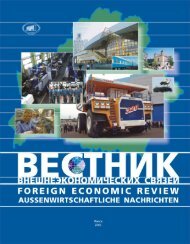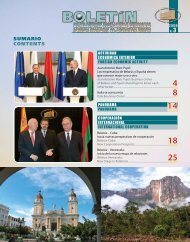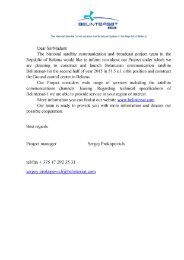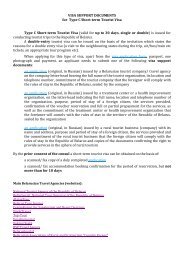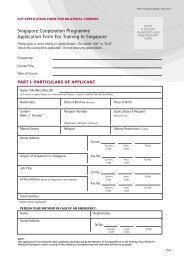BOX 2.2Acquisitions by the South of brands in the NorthIn 2011, 61 of the world’s biggest corporations on the Fortune 500 list wereChinese, 8 were Indian and 7 Brazilian. Just five years earlier, China had 16on the list, India 5 and Brazil 3. The South is going global through outwardinvestment using mergers and acquisitions. The acquisition of veneratedbrands from the North by companies in lower and upper middle-incomecountries is a portent of the rise of the South. In 2005, the Chinese companyLenovo bought IBM’s laptop division for $1.25 billion and took over$500 million of its debt. In 2010, Zhejiang Geely purchased the Swedishcar company Volvo. In 2011 alone, Chinese firms spent $42.9 billion on aneclectic mix of more than 200 acquisitions: Sany Heavy Industry Co. acquiredPutzmeister, Germany’s largest concrete pump maker; Liugong MachineryCo. Ltd. purchased the Polish construction equipment manufacturer HutaStalowa Wola; and Shandong Heavy Industry Group bought a 75% stake inItaly’s Ferretti Group, a luxury yacht maker.India’s Tata Group acquired the Anglo-Dutch steel firm Corus for$13.3 billion in 2007 and Jaguar Land Rover for $2.6 billion in 2008. TheAditya Birla Group bought US aluminium firm Novelis in 2007 and ColumbianChemicals in 2011. Mahindra and Mahindra acquired Sangyong, a bankruptKorean carmaker. Brazil’s food companies have also been active: in 2007,JBS Friboi bought Swift, a US rival, to ease its entry into the United States.In 2011, Turkish companies made 25 deals worth nearly $3 billion. One ofTurkey’s famous acquisitions is Godiva, a Belgian chocolate manufacturer,bought for $850 million by Yildiz Holding. There are scores of lesser knownpurchases of smaller brands from the North by companies in Southeast Asiaand the Arab States. (Many big purchases are also South–South. In 2010,India’s Bharti Airtel acquired the African operations of Zain for $10.7 billion,and China spent $9.8 billion in 27 deals across Brazil, India, the RussianFederation and South Africa.)South–North acquisitions are often interpreted in patriotic terms.Whether the deals help short-run profitability and value creation is unclear.In the long run, however, the strategic motives (outside the resource sector)appear to be about acquiring proprietary knowledge, skills and competenciesthat will help companies expand abroad and at home. Acquiring anestablished, albeit struggling, brand from the North gives companies fromthe South a foothold in mature markets. The acquiring companies lower theircost base by diversifying and globalizing supply chains and gain the technologyand tacit knowhow (such as risk management or credit rating in the caseof financial institutions) to enhance operating capabilities.Source: HDRO; China Daily 2012; The Economist 2011a,b, 2012a; Deloitte 2012a,b; Luedi 2008.services. In this way, opportunities to participatein international production havewidened for new entrants—as for Malaysiain the 1970s, Thailand in the 1980s, China inthe 1990s and Viet Nam today.The North has played an important role inthis rise of the South, just as the South is contributingto the North’s recovery from the economicslowdown (box 2.3). International productionnetworks have been driven mainly by finaldemand in the North. The surge in integratedproduction networks within Asia alone resultedin a high-technology export boom of nearly$320 billion between 1995 and 2005. 26Personal networksMany transnational opportunities in both tradeand investment arise through personal connections,often between international migrantsand their countries of origin. In 2010, an estimated3% of the world’s people (215 million)were first-generation immigrants, 27 and closeto half of them lived in developing countries. 28Almost 80% of South–South migration takesplace between bordering countries. 29Migrant diasporas are a huge source offoreign exchange. In 2005, South–Southremittances were estimated at 30%–45% ofworldwide remittances. 30 Diasporas are alsoa source of information about market opportunities.Diasporas can be associated with increasedbilateral trade and FDI. 31 For example,US multinational firms with a high proportionof employees from particular countries haveless need to rely on joint-venture partners incountries with which their employees havecultural ties. 32Links can also be strengthened when migrantsreturn to their home country. Manyinformation technology professionals inCalifornia’s Silicon Valley, for example, havetaken their ideas, capital and networks backwith them when they return to their homecountries. Other returnees are building newinfrastructure, universities, hospitals andbusinesses. Returning entrepreneurs stay intouch with former colleagues, facilitatingthe diffusion of business information. Crossborderscientific collaboration also disproportionatelyinvolves scientists with diasporaties. 33Other flows of information are made possibleby the widening penetration of the Internetand new social media. Between 2000 and2010, average annual growth in Internet use48 | HUMAN DEVELOPMENT REPORT <strong>2013</strong>
BOX 2.3Ties that bind: the mutual dependence of North and SouthA substantial share of South–South trade, especially in manufactured partsand components, is driven by demand in the North. This makes the countriesof the South sensitive to shocks in the North. After the 2008 global financialcrisis, for instance, exports from Southeast Asia to Japan, the EuropeanUnion and the United States fell about 20% between 2008 and 2009. Thepercentage drop in China’s exports to these economies was also in doubledigits.The North is also increasingly relying on the South to power its own rebound.Since 2007, US exports to China and Latin America and the Caribbeanhave grown two and a half times faster than US exports to traditional marketsin the North. Helped by a weak dollar and increasing purchasing powerin the South, expansion of US exports involved not only traditional sectorssuch as aircraft, machinery, software and Hollywood movies, but also new,high-value services such as architecture, engineering and finance. BehindShanghai’s booming architectural wonders (including Shanghai Towers,which will be the country’s tallest building in 2015) are US designers andstructural engineers, who are drawing an ever-increasing share of fees androyalties from services exported to Brazil, China and India.Furthermore, a growing “app economy” supported by such companiesas Apple, Facebook and Google employs more than 300,000 people whosecreations are easily exported across borders. Zynga, a large company thatmakes online games and mobile applications, recorded $1.1 billion inrevenue in 2011, a third of it from players outside the United States. Theimpact of a growing consumer class in the South is felt not only in services,but also in manufacturing and commodities. A third of US exportsare now accounted for by firms employing fewer than 500 people; throughnew techniques, such as three-dimensional printing, many are recapturingmarkets once lost to imports. Emerging markets have also revived the USrole as a commodity producer (of grains, for example). These shifting tradepatterns suggest that a slowdown in the South would halt growth in thenewly dynamic exports from the North, just as the recession in the Northhit the South.Source: HDRO; The Economist 2012b.was exceptionally high in around 60 developingcountries (figure 2.3). 34 Of the 10 countrieswith the most users of popular social networkingsites such as Facebook, 6 are in the South. 35While these rates reflect in part the low base in2000, the spread and adoption of new mediahave revolutionized many sectors across diversecountries (box 2.4).Impetus from human developmentSuccessful performance in trade, investmentand international production also depends onrising levels of human development, as illustratedby the association between high exportearnings per capita and achievement in educationand health (figure 2.4). The more successfulcountries in the upper right quadrantof the figure also tend to have better economicopportunities for women. Increased tradedraws new workers, often women, into thelabour market, expanding their choices. Thesenew workers do not always benefit from goodworking conditions; efforts to keep costs lowcan put pressure on wages and work environments.Some governments may be reluctant toexpand worker rights, if they believe it wouldraise production costs and reduce competitiveness(box 2.5). 36The capacity of people and institutions alsoaffects the benefits from FDI. Host countriesneed to invest in the capacity of their peopleto identify, assimilate and develop the usefulknowledge embedded in foreign capital andideas. 37 Indeed, an educated and healthyworkforce is often a key factor in influencingthe decision of foreign investors on where tolocate. This positive association between FDIinflows and achievements in health and educationis evident for a sample of 137 countries(figure 2.5). 38This relationship between a skilled populaceand inward foreign investment tends tobe mutually reinforcing. But there are outliers.FDI could still flow to countries withmodest achievements in human developmentif they are exceptionally well endowed innatural resources. Between 2003 and 2009,for instance, many resource-rich Africancountries where FDI contributed substantiallyto economic growth saw some of thelowest nonincome <strong>Human</strong> <strong>Development</strong>Index (HDI) values. 39 However, the impacton development is limited when such investmentsare confined to enclaves and delinkedfrom the rest of the economy. Spilloverbenefits from FDI are unlikely to be widespreadif there is no sustained investment inpeople’s capabilities. In this regard, relativelyHost countries need toinvest in the capacity oftheir people to identifyand use the knowledgeembedded in foreigncapital and ideasChapter 2 A more global South | 49
- Page 1 and 2:
WNSEHuman DevelopmentReport 2013The
- Page 3 and 4:
Human Development Report 2013The Ri
- Page 5 and 6:
Human Development Report 2013 TeamD
- Page 7 and 8:
Finally, the Report also calls for
- Page 9 and 10: Heather Simpson, Ben Slay, Mounir T
- Page 11 and 12: 3.6 India’s Supreme Court issues
- Page 13 and 14: OverviewOne of the most heartening
- Page 15 and 16: and sustainability are fully incorp
- Page 17 and 18: Without investment in people, retur
- Page 19 and 20: opportunity to reap the full benefi
- Page 21 and 22: Woods institutions, the United Nati
- Page 23 and 24: IntroductionWhen developed economie
- Page 25 and 26: leading economies—Brazil, China a
- Page 27 and 28: comparable access to information, e
- Page 29 and 30: mobile phones: cellular banking is
- Page 32 and 33: “The political problem ofmankind
- Page 34 and 35: BOX 1.1Fairness, macroeconomics and
- Page 36 and 37: BOX 1.3Amartya Sen, Nobel Laureate
- Page 38 and 39: FIGURE 1.1Income per capita is risi
- Page 40 and 41: BOX 1.4Subjective indicators of wel
- Page 42 and 43: FIGURE 1.4There is notable variatio
- Page 44 and 45: FIGURE 1.6Most regions show declini
- Page 46 and 47: Progress in humandevelopment achiev
- Page 48 and 49: BOX 1.7Social competencies: human d
- Page 50 and 51: TABLE 1.3Inequality and satisfactio
- Page 52 and 53: Not all countries havethe precondit
- Page 54 and 55: “When the music changes,so does t
- Page 56 and 57: BOX 2.1The South’s integration wi
- Page 58 and 59: FIGURE 2.1As a share of world merch
- Page 62 and 63: FIGURE 2.3Between 2000 and 2010, In
- Page 64 and 65: FIGURE 2.4Export earnings per capit
- Page 66 and 67: BOX 2.6Final assembly is about more
- Page 68 and 69: Instead of having a centreof indust
- Page 70 and 71: FIGURE 2.6Emerging market economies
- Page 72 and 73: Developing countriestrade more amon
- Page 74 and 75: “We cannot expect thatall nations
- Page 76 and 77: TABLE 3.1Selected developing countr
- Page 78 and 79: A common featureof countries thatha
- Page 80 and 81: More important thangetting prices r
- Page 82 and 83: BOX 3.5Eastern Europe and Central A
- Page 84 and 85: States have to beconscious that the
- Page 86 and 87: As countries develop,they tend to d
- Page 88 and 89: Having weathered theAsian financial
- Page 90 and 91: Providing publicservices that contr
- Page 92 and 93: Advancing health requiresmore than
- Page 94 and 95: Universal public healthand educatio
- Page 96 and 97: • China. The Minimum Livelihood G
- Page 98 and 99: “Each generation will reap whatth
- Page 100 and 101: concerns will make for a complex en
- Page 102 and 103: A greater emphasison education cans
- Page 104 and 105: FIGURE 4.1Under the fast track scen
- Page 106 and 107: Around the worldpeople are calling
- Page 108 and 109: FIGURE 4.4Different environmental s
- Page 110 and 111:
FIGURE 4.5Education policies can al
- Page 112 and 113:
BOX 4.2China and Ghana: who benefit
- Page 114 and 115:
FIGURE 4.8countries thus converge t
- Page 116 and 117:
“Let us join hands to try tocreat
- Page 118 and 119:
Areas of globalinternational concer
- Page 120 and 121:
Addressing climatechange requires t
- Page 122 and 123:
International governanceis increasi
- Page 124 and 125:
BOX 5.2Jo Leinen, Member of the Eur
- Page 126 and 127:
facilitates reserve investments and
- Page 128 and 129:
Responsible sovereigntytakes the lo
- Page 130 and 131:
FIGURE 5.1Under the accelerated pro
- Page 132 and 133:
Good policymakingrequires greater f
- Page 134 and 135:
A fair and less unequalworld requir
- Page 137 and 138:
NotesOverview1 Atsmon and others 20
- Page 139 and 140:
25 Blinder 2006.26 UNIDO 2009.27 UN
- Page 141 and 142:
which is 61.7 deaths per 1,000 live
- Page 143 and 144:
ReferencesAbdurazakov, A., A. Minsa
- Page 145 and 146:
urban_world_cities_and_the_rise_of_
- Page 147 and 148:
Kamau, P., D. McCormick, and N. Pin
- Page 149 and 150:
Labor Administration. Geneva: Inter
- Page 151 and 152:
Human Development Report 2013The Ri
- Page 153 and 154:
Statistical acknowledgementsThe Rep
- Page 155 and 156:
Key to HDI countries and ranks, 201
- Page 157 and 158:
Human Development Report 2013The Ri
- Page 159 and 160:
Human Development Report 2013The Ri
- Page 161 and 162:
Human Development Report 2013The Ri
- Page 163 and 164:
Human Development Report 2013The Ri
- Page 165 and 166:
Human Development Report 2013The Ri
- Page 167 and 168:
Human Development Report 2013The Ri
- Page 169 and 170:
Human Development Report 2013The Ri
- Page 171 and 172:
Human Development Report 2013The Ri
- Page 173 and 174:
Human Development Report 2013The Ri
- Page 175 and 176:
Human Development Report 2013The Ri
- Page 177 and 178:
Human Development Report 2013The Ri
- Page 179 and 180:
Human Development Report 2013The Ri
- Page 181 and 182:
Human Development Report 2013The Ri
- Page 183 and 184:
Human Development Report 2013The Ri
- Page 185 and 186:
Human Development Report 2013The Ri
- Page 187 and 188:
Human Development Report 2013The Ri
- Page 189 and 190:
Human Development Report 2013The Ri
- Page 191 and 192:
Human Development Report 2013The Ri
- Page 193 and 194:
Human Development Report 2013The Ri
- Page 195 and 196:
Human Development Report 2013The Ri
- Page 197 and 198:
Human Development Report 2013The Ri
- Page 199 and 200:
Human Development Report 2013The Ri
- Page 201 and 202:
Human Development Report 2013The Ri
- Page 203 and 204:
Human Development Report 2013The Ri
- Page 205 and 206:
Human Development Report 2013The Ri
- Page 207 and 208:
Human Development Report 2013The Ri
- Page 209 and 210:
Human Development Report 2013The Ri
- Page 211 and 212:
Statistical referencesADB (Asian De
- Page 213 and 214:
Core features of the model pertinen
- Page 215 and 216:
Countries and HDI ranks in 2012 and







